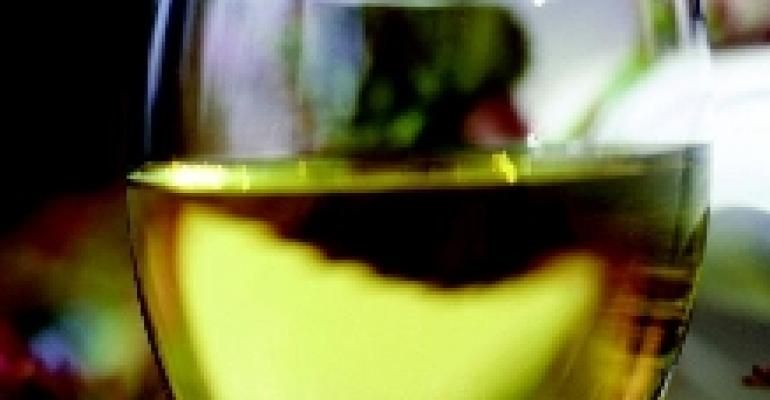 |
| SAVOR THE FLAVOR: Pair spicy cuisines with fuller-bodied white wines. |
 |
| GLASS ACTION: Offer food-friendly wines to keep guests coming back to your restaurant. |
Rock stars, Hollywood idols, celebrity chefs and reality TV participants are more than icons of pop culture. They're largerthan-life phenomena that represent all that is American. Our wine tastes have evolved in the same way: Big, bold and in-your-face.
It's easy to understand why many restaurant guests opt for big Napa names. Uncorking full-flavored wines that have scored well with the critics is as American as apple pie, and it guides bottle-buying trends across the country. No one understands this more than Brad Dixon, one of three busy sommeliers at Bern's Steakhouse in Tampa. With more than 2,500 American wines on his list (90% from California), Dixon believes that selling California wines is easier than selling wines from lesser-known regions.
"Consumers are more familiar with Napa producers and tend to order what they know," Dixon says. The same holds true for the haute-cuisine crowd at Cafè Boulud in Palm Beach. Boulud's intrepid sommelier Jenny Benzie keeps serious restaurant wines such as Opus One, Cain 5, Jordan, Insignia and Caymus on her list as guests ask for them by name. "They want California reds and love anything from Napa–just because it is from Napa," Benzie says.
But thanks to the popularity of televised food shows and movies such as "Sideways" and " Mondovino," wine-buying habits are slowly changing, both behind the bar and at the table. While more Americans are learning to sip and swirl like a pro, savvy restaurant managers create memorable dining experiences by tempting guests with food-friendly wines from outside of Northern California. Back at Bern's Steakhouse, that means including vinous gems such as Ken Wright Cellars Pinot Noir from Oregon, L'Ecole No. 41 Columbia Valley Merlot from Washington and spicy Rhone-styled blends such as Tablas Creek Vineyard from California's Central Coast on the list. How do these wines differ from their Northern California counterparts? Simply put, wines crafted in these regions benefit from cooler climates, making them excellent food wines with lip-smacking acidity and slightly less alcohol.
Adam Rieger, Wine Director at Bobby Flay's latest New York City addition, Bar American, likes to pair cool climate wines with Flay's signature dishes. Armed with the basic principles of food and wine pairing, Rieger sometimes steers guests away from California selections to avoid high alcohol that turns up the heat on spicy foods. Instead, Rieger tackles spiciness with cool-climate Rieslings or fuller-bodied whites such as Lorca Pinot Gris from Monterey County. The wine's flavor profile of ripe pear, nectarine and hints of dry flowers perfectly partners with Flay's Southwestern spices. For price sensitive guests, these wines also represent a better dollar-to-quality ratio, while simultaneously providing varietal identity and regional integrity.
Determined to boost wine sales along with customer loyalty, Sommelier Michael Tomaselli of Vue Restaurant in Hudson, OH, has replaced house "red and whites" with an affordable wine-by-the-glass program. Tomaselli beats the competition by offering a good selection of interesting American wines such as Willakenzie Estate Pinot Noir from Oregon, Barnard Griffin Merlot from Washington and Harpersfield Pinot Gris from Ohio as glass pours. In each case, the wine offers lots of fruit and crisp acidity to make them partner well with Vue's eclectic menu.
In Detroit, Michelle DeHayes, deputy wine director and sommelier for Matt Prentice Restaurant Group, takes the business of looking out for her guests at No.VI Chop House one step further by putting American "upandcomers" on her list. In addition to featuring Washington State-produced Bordeaux-style blends from Matthews Cellars and Andrew Will Winery, DeHayes' list includes two bubble-worthy American sparklers; L. Mawby from Michigan's quality Leelanau Peninsula and Gruet Winery from Albuquerque, New Mexico. Fondly promoted as "wines that deliver at their price point," these are the bottles De-Hayes loves to sell. "Today's customers are more wine savvy than they were five years ago. Having a diverse wine list shows your customers that you are working to create a memorable experience instead of simply building a list based on ratings." DeHayes believes the strategy keeps her guests coming back.
Although American wines from Napa and Sonoma rule, it's a big country. Focusing your wine list on American-made wines does not mean it has to be routine or predictable. Whether you credit the hoards of information on the internet or the recent attention from Hollywood, the American wine consumer is ready to try new labels. A few are even ready to take their first sips outside of California. Cheers.
—Marianne Frantz
Marianne Frantz, CWE is founder and president of The Cleveland Wine School.
| Top Ten Wine Service Tips Whether your establishment is formal or casual, knowing how to serve a bottle of wine properly is a must. Here are a few tricks of the trade that will score big points with your wine-loving guests.
|
| The Art of Selling Wine So what does America's thirst for wine knowledge mean for restaurant lists across the country? Plenty. For starters, many restaurant managers are realizing that a bit of staff training goes a long way to promote customer service and higher check averages. Master Sommelier Matthew Citriglia shares a few tips that can make a real difference in your beverage program:
|





